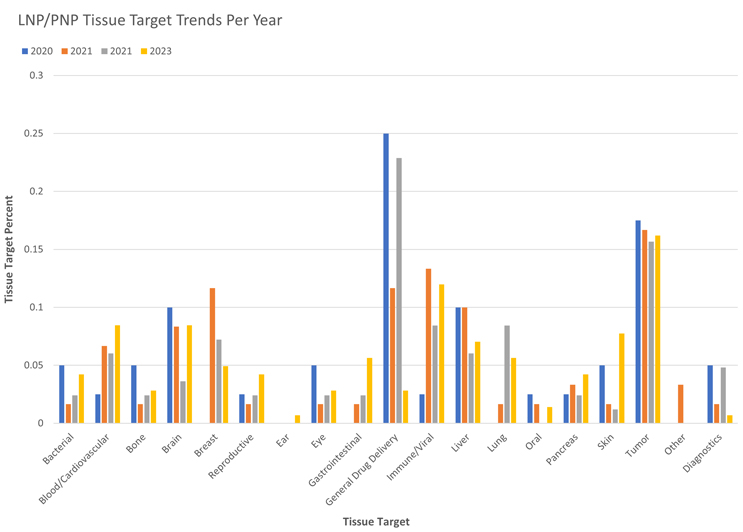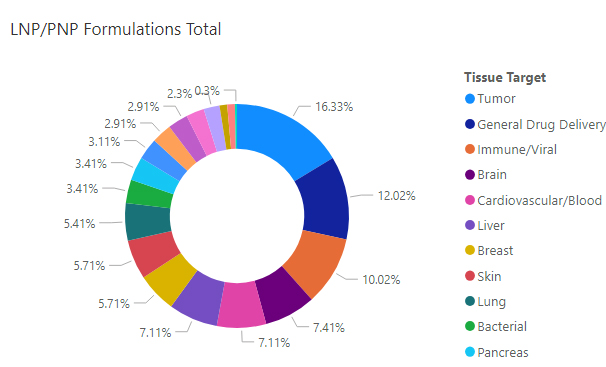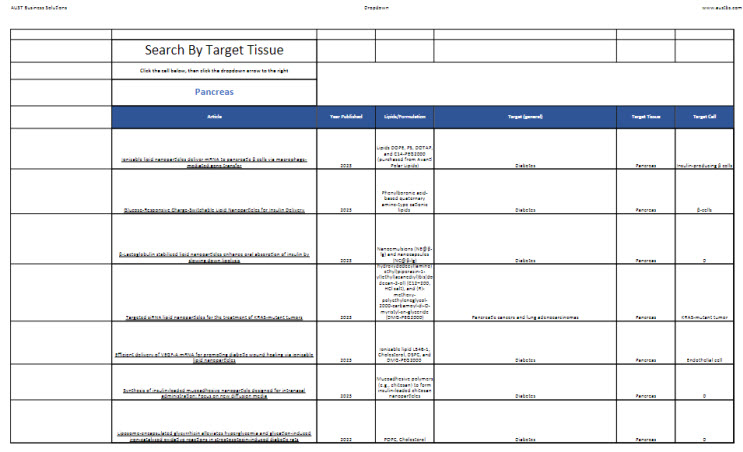4 Major Trends In Lipid Nanoparticle Research
By Alexander K. Aust and Abigael Frederick, Aust Business Solutions

This project sprouted from curiosity following a torrent of new research on lipid and polymer nanoparticles.
In the wake of COVID-19, pharmaceutical companies directed their attention to messenger RNA (mRNA) vaccine manufacturing. But nucleic acids are notoriously unstable, and vaccine manufacturers gravitated toward lipid and polymer system formulations to encapsulate these therapeutics. This motivated companies to focus on lipid and polymer nanoparticle carrier research and development.
We saw new research pouring out of corporate and university labs on the heels of advancements in nucleic acid therapeutic capabilities, including specialized medicine, cancer treatment, gene therapy, and vaccine development.
We began cataloging new polymer nanoparticles (PNP) and lipid nanoparticle (LNP) research. Over time, we saw trends emerge, most recently with a heavy focus on oncology, neurology, and infectious disease therapies, as well as mRNA.
We realized many drug developers working on mRNA and other modalities could benefit from a public database of LNP and PNP research as they search for ideal couriers to deliver their payloads.
View and Download the Database
Editor's note: This database and report has been updated. The new database includes links to the most recent research plus additional information about payloads. See the latest here.
How To Use The Data
Our data provides a far-reaching review of the LNP and PNP research landscape from 2020 to 2023.
We had early-stage drug development in mind as we assembled the database. Drug developers can find it useful when researching formulations for specific indications and targets.
Researchers can sort the database to find journal articles related to specific target tissues and, in many cases, target cells. They can sort and search based on the lipid or formulation studied.
Each record includes the journal title, the year published, and a permalink to the publication.
Lipid And Polymer Nanoparticle Formulation Trends In 2023
The next generation of LNPs and PNPs includes solid lipid nanoparticles, cationic lipids, chitosan-coated polymers, and many others. Lipid and polymer nanoparticles have the capacity to protect drugs from harsh bodily environments, improve medication storage, and are biocompatible and biodegradable. For these reasons and numerous others, the market focus has now been oriented toward developing nanoparticles as carriers for innovative medications.


Nanoparticles In Oncology
The largest application of nanoparticle carriers is cancer treatment. Current nanoparticle formulations have proven to be more bioavailable and antitumor-selective compared to conventional, unencapsulated drugs. This allows for a decrease in targeting non-cancerous cells, increased drug residence time, controlled drug release, and increased solubility of hydrophobic medications. Solid lipid nanoparticles and ionizable nanoparticles have been the main carriers with their ability to target tumorous brain, lung, and various epithelial tissues.
Nanoparticles In Nucleic Acids
Nucleic acid-carrying nanoparticles are newly emerging drugs that are capable of transporting hydrophilic and polyvalent anionic medications through cellular membranes. Nucleic acid medications were previously inhibited from crossing cell biological membranes. This issue has been resolved by encapsulating medications within nanoparticles able to pass through the blood-brain barrier.
These carriers also protect from nuclease degradation and improve the longevity of medication within the body. Some nucleic acid carriers include the COVID mRNA vaccine, Flu A and B treatment, and new CRISPR technology. These carriers are generally composed of PEGylated lipids, solid lipid nanoparticles, or lipidoid-substituted lipids.
Nanoparticles In Neurology
Crossing the blood-brain barrier has always been a challenge for medications that repair neurons and synapses while also providing neurogenesis within the central and peripheral nervous system.
Nanoparticles that target inflammatory molecules, catalyze reduction-oxidative reactions, move across the blood-brain barrier, and control drug release have become the center of attention for neurological medications. Diseases such as Alzheimer’s, dementia, and neuroinfections have been the main target of these nanoparticles. Nanoparticle formulations prevalent in neurology include solid lipid nanoparticles, DOPE-modified nanoparticles, and bioactive omega-3 polyunsaturated fatty acids.
Nanoparticles In Infectious Disease
Nanoparticles are more recently being used to fight infectious diseases. The focus includes preventing, disrupting, and inhibiting or dispersing bacterial biofilms present in many infections. Using nanoparticles to fight these infections can aid in the antibiotic resistance crisis currently unfolding. Gold nanoparticles have been shown to disrupt the bacterial diffusion barrier and increase bacterial susceptibility to the antibiotic tobramycin.
Infectious diseases such as tuberculosis, vulvovaginal candidiasis, rabies, and sepsis are the primary focus of nanoparticle therapeutics. Some infectious disease nanoparticle formulations include enzyme-responsive biomimetic solid lipid nanoparticles, nanoemulsions, and solid lipid nanoparticles.
This database and report has been updated. The new database includes links to the most recent research plus additional information about payloads. See the latest here.
About the Authors:
 Alexander Aust, M.S., MBA, is the cofounder and owner of Aust Business Solutions, a pharmaceutical consultancy based in Maryville, TN, where he focuses on strategic planning and partnerships and technical support. The firm provides CMC and project management services, assists with regulatory submissions, and helps to implement new technology. Aust serves as a senior project manager for the Parenteral Drug Association. He earned his MBA from Ball State University and an M.S. degree from Purdue University in molecular and cellular biology.
Alexander Aust, M.S., MBA, is the cofounder and owner of Aust Business Solutions, a pharmaceutical consultancy based in Maryville, TN, where he focuses on strategic planning and partnerships and technical support. The firm provides CMC and project management services, assists with regulatory submissions, and helps to implement new technology. Aust serves as a senior project manager for the Parenteral Drug Association. He earned his MBA from Ball State University and an M.S. degree from Purdue University in molecular and cellular biology.
 Abigael Frederick is a business analyst intern with Aust Business Solutions. She earned her microbiology B.S. from Indiana University along with a minor in chemistry. She is beginning her Ph.D. in biochemistry, cell, and developmental biology at Emory University. She spent her college career exploring pharmaceutical and academic research with a focus on immunotherapy, bacterial genetics, and drug delivery systems.
Abigael Frederick is a business analyst intern with Aust Business Solutions. She earned her microbiology B.S. from Indiana University along with a minor in chemistry. She is beginning her Ph.D. in biochemistry, cell, and developmental biology at Emory University. She spent her college career exploring pharmaceutical and academic research with a focus on immunotherapy, bacterial genetics, and drug delivery systems.

